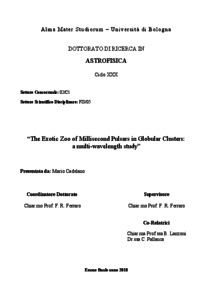Cadelano, Mario
(2018)
The Exotic Zoo of Millisecond Pulsars in Globular Clusters: a multi-wavelength study, [Dissertation thesis], Alma Mater Studiorum Università di Bologna.
Dottorato di ricerca in
Astrofisica, 30 Ciclo. DOI 10.6092/unibo/amsdottorato/8575.
Documenti full-text disponibili:
![[img]](http://amsdottorato.unibo.it/8575/1.hassmallThumbnailVersion/tesi_finale_AMS.pdf)  Anteprima |
|
Documento PDF (English)
- Richiede un lettore di PDF come Xpdf o Adobe Acrobat Reader
Disponibile con Licenza: Salvo eventuali più ampie autorizzazioni dell'autore, la tesi può essere liberamente consultata e può essere effettuato il salvataggio e la stampa di una copia per fini strettamente personali di studio, di ricerca e di insegnamento, con espresso divieto di qualunque utilizzo direttamente o indirettamente commerciale. Ogni altro diritto sul materiale è riservato.
Download (30MB)
| Anteprima
|
Abstract
This work is focused on the study of millisecond pulsars in globular cluster by using multi-wavelength observations.
Radio observations have been used to search for and timing the pulsars. An alternative method to search for very faint pulsars is first presented and then successfully applied to observations of stellar system Terzan 5, leading to the discovery of three new pulsars.
The update of the timing solutions of 9 pulsars in M28 is then presented. The timing solutions now cover a data span of 10 years and provide spin, astrometric and orbital properties for all the systems. For the case of the eccentric binaries M28C and M28D, post-Keplerian corrections to the orbit have been measured in order to derive the masses of the binary components. The measurement of the pulsar proper motions allowed to constrain the cluster motion as a whole and its orbit around the Galaxy. Finally, the pulsar spin and orbital period derivatives have been used to measure their accelerations induced by the cluster potential field.
Optical observations have been used to search for millisecond pulsar optical counterparts. Six new companion stars have been discovered. In particular, four companions turned out to be He white dwarfs. One companion turned out to be a faint and non-degenerate object, strongly affected by heating of the stellar side exposed to the pulsar flux. Finally, one companion is a main-sequence star which shows Hα emission likely due to a low-level mass transfer. Furthermore, we identified the companion star to a transient low-mass X-ray binary. This companion turned out to be a sub-giant branch star and therefore this system is likely in a very early phase of the mass accretion stage.
Conclusion are drawn in the final chapter, where the evolution of millisecond pulsars is discussed and possible future developments are suggested.
Abstract
This work is focused on the study of millisecond pulsars in globular cluster by using multi-wavelength observations.
Radio observations have been used to search for and timing the pulsars. An alternative method to search for very faint pulsars is first presented and then successfully applied to observations of stellar system Terzan 5, leading to the discovery of three new pulsars.
The update of the timing solutions of 9 pulsars in M28 is then presented. The timing solutions now cover a data span of 10 years and provide spin, astrometric and orbital properties for all the systems. For the case of the eccentric binaries M28C and M28D, post-Keplerian corrections to the orbit have been measured in order to derive the masses of the binary components. The measurement of the pulsar proper motions allowed to constrain the cluster motion as a whole and its orbit around the Galaxy. Finally, the pulsar spin and orbital period derivatives have been used to measure their accelerations induced by the cluster potential field.
Optical observations have been used to search for millisecond pulsar optical counterparts. Six new companion stars have been discovered. In particular, four companions turned out to be He white dwarfs. One companion turned out to be a faint and non-degenerate object, strongly affected by heating of the stellar side exposed to the pulsar flux. Finally, one companion is a main-sequence star which shows Hα emission likely due to a low-level mass transfer. Furthermore, we identified the companion star to a transient low-mass X-ray binary. This companion turned out to be a sub-giant branch star and therefore this system is likely in a very early phase of the mass accretion stage.
Conclusion are drawn in the final chapter, where the evolution of millisecond pulsars is discussed and possible future developments are suggested.
Tipologia del documento
Tesi di dottorato
Autore
Cadelano, Mario
Supervisore
Co-supervisore
Dottorato di ricerca
Ciclo
30
Coordinatore
Settore disciplinare
Settore concorsuale
Parole chiave
Globular Clusters, Millisecond Pulsars, Binaries, Searching, Timing, Optical, Radio, Neutron Stars
URN:NBN
DOI
10.6092/unibo/amsdottorato/8575
Data di discussione
18 Aprile 2018
URI
Altri metadati
Tipologia del documento
Tesi di dottorato
Autore
Cadelano, Mario
Supervisore
Co-supervisore
Dottorato di ricerca
Ciclo
30
Coordinatore
Settore disciplinare
Settore concorsuale
Parole chiave
Globular Clusters, Millisecond Pulsars, Binaries, Searching, Timing, Optical, Radio, Neutron Stars
URN:NBN
DOI
10.6092/unibo/amsdottorato/8575
Data di discussione
18 Aprile 2018
URI
Statistica sui download
Gestione del documento:


 Login
Login
